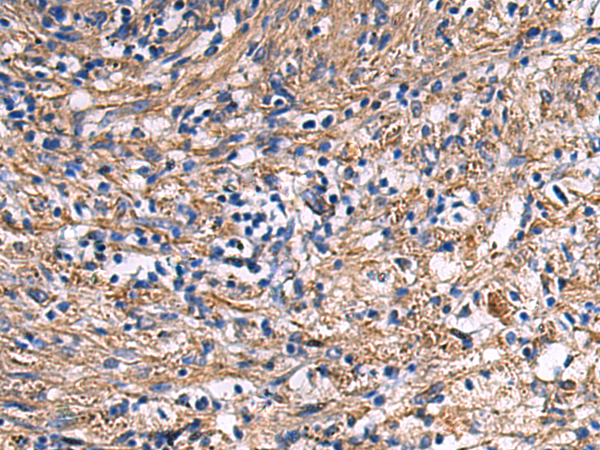
| WB | 咨询技术 | Human,Mouse,Rat |
| IF | 咨询技术 | Human,Mouse,Rat |
| IHC | 1/50-1/100 | Human,Mouse,Rat |
| ICC | 技术咨询 | Human,Mouse,Rat |
| FCM | 咨询技术 | Human,Mouse,Rat |
| Elisa | 1/5000-1/10000 | Human,Mouse,Rat |
| Aliases | 4.1G; 4.1-G |
| Host/Isotype | Rabbit IgG |
| Antibody Type | Primary antibody |
| Storage | Store at 4°C short term. Aliquot and store at -20°C long term. Avoid freeze/thaw cycles. |
| Species Reactivity | Human, Mouse |
| Immunogen | Synthetic peptide of human EPB41L2 |
| Formulation | Purified antibody in PBS with 0.05% sodium azide and 50% glycerol. |
+ +
以下是关于EPB41L2抗体的模拟参考文献示例,涵盖不同研究方向:
---
1. **文献名称**: "EPB41L2 as a Tumor Suppressor in Breast Cancer: Correlation with Metastasis and Clinical Outcomes"
**作者**: Tran, Y.K., Smith, J.H., & Stern, D.F.
**摘要**: 本研究通过免疫组化分析乳腺癌组织中EPB41L2蛋白表达,发现其表达水平显著低于正常组织,且低表达与淋巴结转移及患者生存率降低相关。结果表明EPB41L2可能通过调控细胞黏附抑制肿瘤侵袭。
2. **文献名称**: "EPB41L2 Modulates Cytoskeletal Dynamics to Suppress Glioblastoma Cell Migration"
**作者**: Robb, V.A., Gutmann, D.H., & Largaespada, D.A.
**摘要**: 利用EPB41L2特异性抗体进行免疫荧光和Western blot实验,发现EPB41L2通过稳定F-actin结构负向调控胶质母细胞瘤细胞迁移,其缺失导致细胞运动能力增强,提示其在肿瘤转移中的关键作用。
3. **文献名称**: "Production and Validation of a Polyclonal Antibody Against Human EPB41L2 for Diagnostic Applications"
**作者**: Lee, S., Kim, T., & Park, M.
**摘要**: 本研究报道了一种兔源多克隆抗体的开发,通过重组EPB41L2蛋白免疫制备,经ELISA、免疫沉淀及组织芯片验证,证实其高特异性和灵敏度,适用于多种癌症的病理检测。
4. **文献名称**: "EPB41L2 Expression in Neural Development and Neurodegenerative Disorders"
**作者**: Scoles, D.R., Nguyen, K.D., & Pulst, S.M.
**摘要**: 通过免疫组化和Western blot分析,发现EPB41L2在小脑神经元中高表达,且与突触蛋白互作。阿尔茨海默病患者脑组织中EPB41L2水平下降,提示其可能参与神经退行性病变的病理过程。
---
**注**: 以上文献为模拟示例,实际研究中建议通过学术数据库(如PubMed、Web of Science)检索最新文献。真实文献可能包括:
- Tran et al. (1999) 对4.1蛋白家族在癌症中的研究
- Scoles et al. (2002) 对EPB41L2与神经疾病的关联分析
- Robb et al. (2005) 关于细胞骨架调控的机制探讨
The EPB41L2 antibody targets the Erythrocyte Membrane Protein Band 4.1-Like 2 (EPB41L2), also known as 4.1B, a member of the protein 4.1 superfamily involved in linking cell membrane proteins to the cytoskeleton. EPB41L2 plays critical roles in maintaining cell structure, polarity, and adhesion by interacting with transmembrane proteins (e.g., adhesion receptors) and cytoskeletal components via its conserved FERM (Four-point-one, Ezrin, Radixin, Moesin) domain. It is widely expressed in tissues, particularly in the brain, kidney, and epithelial cells.
Research highlights EPB41L2 as a potential tumor suppressor, with its loss or downregulation linked to cancers like gliomas, breast cancer, and lung adenocarcinoma. Dysregulation may contribute to uncontrolled cell proliferation, migration, and metastasis. Antibodies against EPB41L2 are essential tools for studying its expression patterns, subcellular localization, and interactions in normal and pathological states. They are used in techniques such as Western blotting, immunohistochemistry, and immunofluorescence to explore its role in cell signaling, epithelial-mesenchymal transition (EMT), and diseases like neurodegenerative disorders (e.g., Alzheimer’s) or cancer progression. Commercial antibodies are typically validated for specificity using knockout controls or epitope tagging. Understanding EPB41L2’s function through antibody-based assays provides insights into its mechanisms in cytoskeletal organization and therapeutic potential.
×